Thalidomide targets EGFL6 to inhibit EGFL6/PAX6 axis-driven angiogenesis in small bowel vascular malformation
- PMID: 32008086
- PMCID: PMC7671996
- DOI: 10.1007/s00018-020-03465-3
Thalidomide targets EGFL6 to inhibit EGFL6/PAX6 axis-driven angiogenesis in small bowel vascular malformation
Abstract
Background: Small bowel vascular malformation disease (SBVM) is the most common cause of obscure gastrointestinal bleeding (OGIB). Several studies suggested that EGFL6 was able to promote the growth of tumor endothelial cells by forming tumor vessels. To date, it remains unclear how EGFL6 promotes pathological angiogenesis in SBVM and whether EGFL6 is a target of thalidomide.
Methods: We took advantage of SBVM plasma and tissue samples and compared the expression of EGFL6 between SBVM patients and healthy people via ELISA and Immunohistochemistry. We elucidated the underlying function of EGFL6 in SBVM in vitro and by generating a zebrafish model that overexpresses EGFL6, The cycloheximide (CHX)-chase experiment and CoIP assays were conducted to demonstrate that thalidomide can promote the degradation of EGFL6 by targeting CRBN.
Results: The analysis of SBVM plasma and tissue samples revealed that EGFL6 was overexpressed in the patients compared to healthy people. Using in vitro and in vivo assays, we demonstrated that an EMT pathway triggered by the EGFL6/PAX6 axis is involved in the pathogenesis of SBVM. Furthermore, through in vitro and in vivo assays, we elucidated that thalidomide can function as anti-angiogenesis medicine through the regulation of EGFL6 in a proteasome-dependent manner. Finally, we found that CRBN can mediate the effect of thalidomide on EGFL6 expression and that the CRBN protein interacts with EGFL6 via a Lon N-terminal peptide.
Conclusion: Our findings revealed a key role for EGFL6 in SBVM pathogenesis and provided a mechanism explaining why thalidomide can cure small bowel bleeding resulting from SBVM.
Keywords: Angiodysplasia; Obscure gastrointestinal bleeding; Proteasome-dependent degradation.
Conflict of interest statement
The authors disclose no conflicts.
Figures
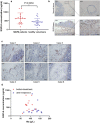
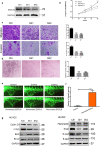
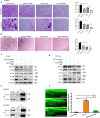
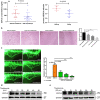


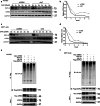

Similar articles
-
HIF-1α and HIF-2α induced angiogenesis in gastrointestinal vascular malformation and reversed by thalidomide.Sci Rep. 2016 Jun 1;6:27280. doi: 10.1038/srep27280. Sci Rep. 2016. PMID: 27249651 Free PMC article.
-
Hypoxia and low-glucose environments co-induced HGDILnc1 promote glycolysis and angiogenesis.Cell Death Discov. 2024 Mar 12;10(1):132. doi: 10.1038/s41420-024-01903-w. Cell Death Discov. 2024. PMID: 38472215 Free PMC article.
-
EGFL6 promotes endothelial cell migration and angiogenesis through the activation of extracellular signal-regulated kinase.J Biol Chem. 2011 Jun 24;286(25):22035-46. doi: 10.1074/jbc.M110.187633. Epub 2011 Apr 29. J Biol Chem. 2011. PMID: 21531721 Free PMC article.
-
The emerging role of EGFL6 in angiogenesis and tumor progression.Int J Med Sci. 2020 May 25;17(10):1320-1326. doi: 10.7150/ijms.45129. eCollection 2020. Int J Med Sci. 2020. PMID: 32624687 Free PMC article. Review.
-
Effective treatment of gastrointestinal bleeding with thalidomide--Chances and limitations.World J Gastroenterol. 2016 Mar 21;22(11):3158-64. doi: 10.3748/wjg.v22.i11.3158. World J Gastroenterol. 2016. PMID: 27003992 Free PMC article. Review.
Cited by
-
Progress of EGFL6 in angiogenesis and tumor development.Int J Clin Exp Pathol. 2022 Nov 15;15(11):436-443. eCollection 2022. Int J Clin Exp Pathol. 2022. PMID: 36507067 Free PMC article. Review.
-
Thalidomide upper limb embryopathy - pathogenesis, past and present management and future considerations.J Hand Surg Eur Vol. 2023 Sep;48(8):699-709. doi: 10.1177/17531934231177425. Epub 2023 May 24. J Hand Surg Eur Vol. 2023. PMID: 37226469 Free PMC article. Review.
-
Dynamic Enhancement Pattern on CT for Predicting Pancreatic Neuroendocrine Neoplasms with Low PAX6 Expression: A Retrospective Observational Study.Diagnostics (Basel). 2020 Nov 9;10(11):919. doi: 10.3390/diagnostics10110919. Diagnostics (Basel). 2020. PMID: 33182335 Free PMC article.
-
EGFL6 regulates angiogenesis and osteogenesis in distraction osteogenesis via Wnt/β-catenin signaling.Stem Cell Res Ther. 2021 Jul 22;12(1):415. doi: 10.1186/s13287-021-02487-3. Stem Cell Res Ther. 2021. PMID: 34294121 Free PMC article.
-
Single-cell RNA-Seq data have prevalent blood contamination but can be rescued by Originator, a computational tool separating single-cell RNA-Seq by genetic and contextual information.bioRxiv [Preprint]. 2025 Jan 13:2024.04.04.588144. doi: 10.1101/2024.04.04.588144. bioRxiv. 2025. Update in: Genome Biol. 2025 Mar 11;26(1):52. doi: 10.1186/s13059-025-03495-9. PMID: 38617220 Free PMC article. Updated. Preprint.
References
MeSH terms
Substances
Grants and funding
- 81670505/National Natural Science Foundation of China
- DLY201501/the Shanghai Municipal Education Commission: Gaofeng Clinical Medicine grant support
- 16CR3113B/the Three,year action plan for Shin Kang of Shanghai
- ZHYXJCZDAL 190005/Cross medical research fund of translational medicine, Shanghai Jiao Tong Universit
LinkOut - more resources
Full Text Sources
Molecular Biology Databases

